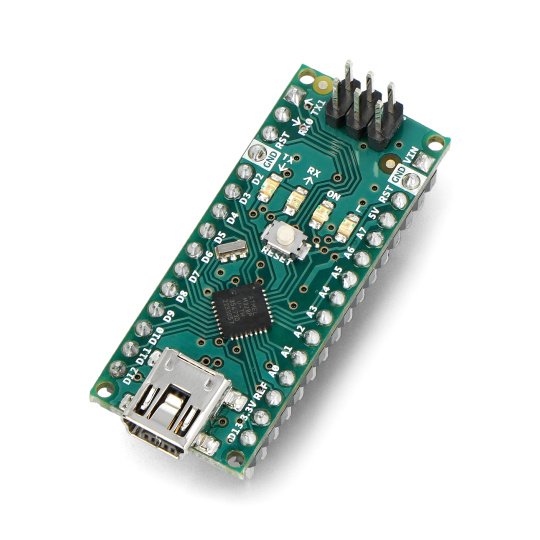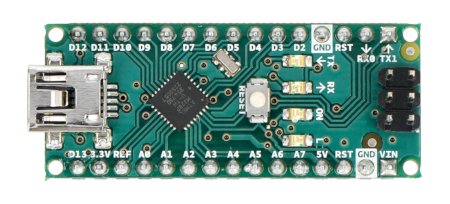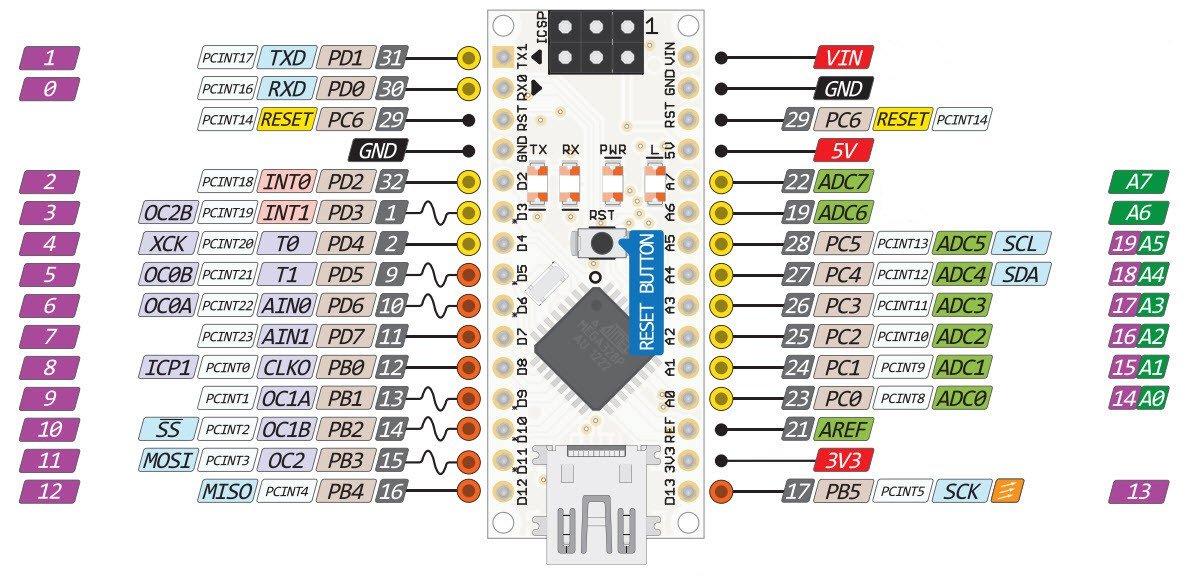Description
The Arduino Nano is a popularversion of Unoin a smaller size: 45 x 18 mm. The board contains an ATmega328 microcontroller equipped with 22 digital input/outputs, 6 of which can be used as PWM outputs (e.g. for motor control), and 8 as analog inputs. The system works with the clock signal with the frequency of 16 MHz and has 32 KB Flash memory and 2 KB RAM SRAM.
|
This version features small size: 45 x 18 mm. Has soldered male connectors on the bottom side of the tile. |
Key features
Below are a few features that distinguish modules Arduino from the other programmable tiles.
| Name | Description |
|---|---|
|
Installed bootloader |
Thanks to bootloader, only appropiate mini-usb cableandsoftware from manufacturer's website are necessary to program the device. |
|
Small size |
This version features small size: 45 x 18 mm. Has soldered male connectors on the bottom side of the tile. |
|
Digital I/O |
22 digital inputs/outputsallow, in particular, to control the LEDs, relays and reading the buttons' states. |
|
Efficiency of current |
The maximum current efficiency for a single output is 40 mA. |
|
Output PWM |
6 PWM outputs allow e.g. to control motors and brightness of the LEDs. |
|
Analog inputs |
8 inputs of built-in digital-analog converter with 10-bit resolution, support, in particular, sensors with analog output. |
|
Serial communication |
The device supports popular communication interfaces, including UART, I2C and SPI, and USB. |
|
Built-in memory |
Atmega328 system with a clock signal with a frequency of 16 MHz, has 32 KB Flash memory, 1 KB EEPROM and 2 KB of RAM SRAM. |
|
Supply pin VIN |
To power the Arduino, you can useany power sourcewith voltage from 6 V to 20 V, which is to be connected to pins VIN (+) and GND. |
|
Supply USB port |
The tile can be powered from the computer via thecable miniUSB, bearing in mind that the maximum power load for the USB port is 500 mA. Arduino has a system that protects the socket from short-circuit and the flow of too high current. |
|
Connector ICSP |
The module has ICSP I/O for connecting an externalAVR programmer. |
|
Built-in led |
The connected led on pin 13 allows debugging simple programs. |
|
Output 3.3 V |
Built-in voltage regulator provides power to external devices with the voltage of 3.3 V with current consumption of 50 mA. |
|
First run To help you get started with the module, we have prepareda tutorial that will help you with the installation and first run of the Arduino environment. |
Specification
- Supply voltage:
- Maximum parameters: 6 V to 20 V (with low current and cooling system)
- Recommended: 7 V to 12 V
- Microcontroller: ATmega328
- Maximum clock frequency: 16 MHz
- SRAM: 2 KB
- Flash memory: 32 KB (2 KB are reserved for the bootloader)
- EEPROM: 1 KB
- Pins I/O: 22
- PWM channels: 6
- Number of analog inputs: 8(channels of converter A/C with 10 bit resolution)
- The mini-usb port for programming
- Serial interfaces: UART, SPI, I2C
- External interruptions
- Dimensions: 45 x 18 mm
Useful links |

















































































































































































































































































































































